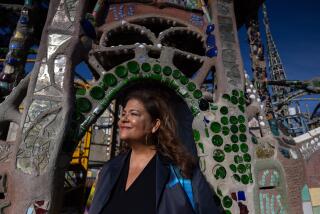Blue plaques that pay tribute to London’s past may be history
LONDON — In this age of deep austerity cuts, plenty of Brits face an uncertain future. But many Londoners are now wondering whether the past is about to get the chop as well.
As any visitor to this teeming capital quickly discovers, history haunts virtually every street corner. Helping to make that palpable are the hundreds of round blue plaques on building fronts informing passersby that some noble or noteworthy person once slept or worked there, or both.
87 Jermyn St., near Piccadilly Circus? Isaac Newton lived here. 58 Sheffield Terrace was home to Agatha Christie in the 1930s, a period during which she wrote such classic whodunits as “And Then There Were None” and “Death on the Nile.”
Vivien Leigh graced 54 Eaton Square, in one of London’s toniest precincts. Mohandas Gandhi studied law while lodging at 20 Barons Court Road. Composer George Frideric Handel breathed his last at 25 Brook St.; by some cosmic coincidence (or joke), guitarist Jimi Hendrix moved in next door, at No. 23, about 200 years later.
More than 850 plaques pay tribute to the great and the good: scientists, actors, philosophers, artists, politicians, athletes, Brits and non-Brits, all of whom have made London a stopping point, a temporary refuge or a permanent home.
But the government-funded body in charge of the blue tablets, English Heritage, recently announced that it was suspending the program because of severe budgets cuts, with no new worthies to be added to the roll of honor for at least two years as officials figure out how to make the program, which costs $400,000 a year, leaner financially.
The decision provoked an immediate outcry. The nationalistic Daily Mail tabloid warned that the blue plaques were in danger of becoming “a thing of the past.” Reports sprang up that a rival organization, the National Trust, might take over the program. A millionaire plumber has also offered to fund and run it.
The furor over the fate of these modest markers has reawakened many Londoners to the unique history of their city, which has often changed the course of world events and made important contributions to humanity, but which many residents take for granted.
“They’re really important history portals that allow us to connect to London’s heritage and past,” David Coughlan, a software developer and dyed-in-the-wool Londoner, says of the plaques. “It’s also nice to walk in the footsteps of famous people.”
The blue plaque program, believed to be the first of its kind in the world and an inspiration for countless imitators in other countries, was first proposed in London in the mid-19th century. Its ambition was decidedly modest: help “travelers up and down in omnibuses” while away the time as they made “a somewhat dull and not very rapid progress through the streets.”
Passengers stuck in traffic on Holles Street in 1867 would’ve looked out on the first commemorative plaque, to the poet Lord Byron, on the facade of his birthplace at No. 24. (The building has since been torn down.) Benjamin Franklin’s onetime home on Craven Street, close to the Thames, was among the first places to be considered for a marker.
The program proved popular and helped spur the preservation of old buildings because of their association with distinguished former inhabitants.
Until now, the only calamities that have halted the program were two world wars. But a steep drop in funding, by a government implementing Britain’s most severe budget cuts in a generation, has convinced English Heritage that it must put the signature blue plaques on hold.
The organization still expects to install tablets for a dozen or so already-approved candidates; composer Felix Mendelssohn will be honored early next month (4 Hobart Place, in Belgravia). But the panel that evaluates nominees is being disbanded, and the number of staff members who work on the program is being scaled back to two from four.
“Our focus over the next two years will be to reduce a backlog of plaques that have already been agreed and to lay the foundations for a long-term future for the scheme that reduces the cost to the taxpayer,” English Heritage says.
Controversy is nothing new for the blue plaque program. Shock and indignation usually follow every announcement of whom the advisory panel approves for a plaque in its closed-door meetings and, more often, whom it rejects.
Wallis Simpson, the American socialite for whom King Edward VIII abdicated, was turned down a few years ago because of rumors that she had an affair with Hitler’s ambassador to London. The panel also decided that the significance of the achievements of Keith Moon, the late drummer for the Who, was “not yet proven,” which prompted another organization to put up its own tribute to him.
Owners of an apartment block on London’s southern fringe have also refused permission for English Heritage to mount a tablet commemorating stripper Phyllis Dixey, whose racy routines scandalized London in the 1940s. Apparently concerned for their reputation, residents want the plaque to use words such as “burlesque dancer” instead of “striptease artiste,” but English Heritage has said no on the grounds that burlesque is an American tradition.
A sizable number of the blue plaques honor foreigners: Karl Marx, Napoleon III, Samuel Morse, Vincent van Gogh, to name a few.
Coughlan, the software developer, has pioneered a website — https://www.plaqueguide.com — that allows anyone with an Internet connection to track down a particular plaque and see a photo of it courtesy of Google’s Street View.
“It says as much about how London has allowed these people to achieve greatness,” Coughlan says, with obvious pride in his hometown. “They’re kind of badges of honor for London itself.”
More to Read
Sign up for Essential California
The most important California stories and recommendations in your inbox every morning.
You may occasionally receive promotional content from the Los Angeles Times.











